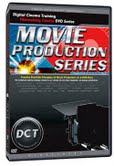The Digital Cinema Course begins by detailed instructions on building a screenplay with proper structure and solid characters. Many screen writing textbooks have also done this, but the course is the first to do it by use of a dramatic short film teaching writers the basics of overcoming obstacles and disasters. This is then furthered by second more concise section outlining how to write in clear instructions. It categorizes specific methods and tools, and inspires writers who may have given up on dramatic storytelling. The following section describes how to physically construct a screenplay, what paper to use, how to bind it, and how to format the content. This is done with the use of computer graphics. Once the storytelling sections are complete, the course moves on to teach film editing. Starting with the history of editing and progressing to current digital nonlinear editing, the section prepares the filmmaker for the field. It abides by the rule that the best cinematographer or director is first a competent editor. After the editing section, the course moves on to discuss filmmaking equipment and gear, from the basic C-stand to the intricate use of color gels and corrective filtration. It prepares filmmakers for the technical aspect of making movies with HMI, tungsten, and fluorescent lighting. After the equipment section, it explores basic production in a controlled studio environment. Lighting, lenses, shots, depth of field, composition, and axes of movement. The course then applies all the concepts learned in the movie production section and puts all the principles to the test on a real movie set. It carries with it all the variables that can assault filmmakers while trying to make a digital film. After the movie production section has been completed, the course moves on to the advanced lighting section. This is the most detailed of the sections, concentrating for hours on the art of lighting a film set with faith to the script's intention. Whether lighting to mimic candlelight, firelight, or fluorescent warehouse lighting, this section discusses the most difficult situations that a cinematographer may confront. Learn Filmmaking from Writing to Post in the most revolutionary training course available to students of film. Discover filmmaking savvy, wisdom, examples, demonstrations, tips and tricks, presented by the people who work in Hollywood day in, day out. Movie Production teaches Scriptwriting, Formatting, Editing, Camera Operation, Lighting, Exposure, Audio, and Directing, all focused on Digital Movies. Screenwriting, Directing, Acting. Add foreground detail and make a dolly move really count, block your actors to match their eyelines, compose your shots to set the audience at ease (or not), and light the set with a minimum of fixtures. Then move onto the set and experience working through 13 different set layouts in detail.

 Please wait...
Please wait...




